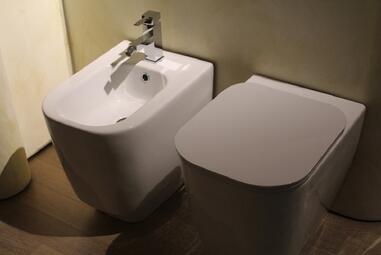
Bidets are not toilets. They are, in fact, specialised fixtures for washing up after using the toilet.
Bidets are available in an assortment of shapes and sizes and are used primarily for one purpose: cleaning the posterior regions. Compared to toilet paper, a bidet is healthier as it provides better hygiene.
Until the invention of toilet paper in 1857, humans used only water for cleaning after visiting the toilet.
In a sense, a bidet takes you back in time. A modern bidet is capable of spraying a steady stream of water at the exact spot, cleaning the most stubborn mess gently and easily.
This exhaustive guide in Q&A format gives an in-depth description of all matters of importance that concerns bidets. We trust you’ll find it easier to find the perfect Bidet toilet for your bathroom after reading this guide.
Click to jump to any of the sections below
- What is a Bidet Toilet? What Does the Word Mean? Who Invented It?
- How Does a Bidet Work?
- Are Bidets Meant for Men, Women, or Both?
- Which Countries Use a Bidet?
- Is a Bidet Hygienic/Sanitary? Can it Cause Infections?
- What Are the Common Misconceptions About Bidets?
- What Are the Different Types of Bidet Toilets?
- What Features Should I Look for When Choosing a Bidet?
- What Are the Top Benefits of Using a Bidet Toilet?
- How Much Does a Bidet Cost?
- Top Bidet Toilet Recommendations
- Shop Bidet Toilets
What is a Bidet Toilet? What Does the Word Mean? Who Invented It?
A bidet toilet is a bathroom fixture with plumbing connections. It’s installed as a separate unit adjacent to the toilet, and the user typically straddles this unit (pony toilet).
The word Bidet, pronounced bee-day or bi-ˈdā, was first used in the 15th century by the French royalty to refer to their pet pony. According to the World Toilet Organization, this term was coined in 1710 referring to furniture, in a French publication.
Christopher Des Rosiers, a French furniture maker, is credited with creating the world’s earliest bidets more than three centuries ago.
How Does a Bidet Work?
A basic model of bidet sprays water so that you are able to clean your posterior region more thoroughly after using the toilet. The sprayer of a bidet toilet connects to the water source in your bathroom.
The mechanism of this sprayer is identical to that of the sprayer in your garden or on your kitchen sink. The water pressure can be adjusted from low to high by turning a knob. The right way to use a bidet toilet is by starting at a low water pressure and increasing it gradually.
Premium models are equipped with an air dryer that helps you dry off. Other features include precise water temperature, nozzle adjustment, a heated seat, and even a nightlight. The risk of plumbing issues in your home is reduced considerably as toilet paper will not enter the plumbing lines.
Cleaning with plain water is also more thorough. Hence, owning a bidet can enhance your quality of life and save you money.
Are Bidets Meant for Men, Women, or Both?
Bidet toilets are truly unisex. There are no bidets manufactured only for men or for that matter, only for women. Since plain water is the best option for cleaning the posterior as well as the frontal regions, bidet toilets are perfect for use by both men and women.
Women stand to benefit a lot as using a bidet helps them manage medical issues such as urinary tract infections (UTI), bladder infections, and haemorrhoids better. For people – whether a man or woman – with mobility issues, a bidet makes it easier to clean down there.
Which Countries Use a Bidet?
Bidets are popular in Portugal, Italy, Argentina, Venezuela, and Japan. Although the word bidet is French, more than 50% of French households don’t have a bidet.
In Europe, other than Portugal and Italy, Spain and Greece also use a bidet. South American nations such as Paraguay, Uruguay, and Chile which are influenced by the Italian culture also use a bidet.
Sadly, in the UK, a nation notorious for lacking in self-hygiene (apologies for telling the truth), only 3% of households had a bidet in 1995. And an early 2000s poll confirmed that less than 5% of Brits use a bidet regularly.
Is a Bidet Hygienic/Sanitary? Can it Cause Infections?
A common misconception about bidets is that water comes from the toilet bowl. However, water comes from the tap. Proponents say that since more faecal matter can be removed when using a bidet compared to toilet paper, a bidet is perfectly hygienic and sanitary.
The main benefit of using a bidet toilet is you won’t contaminate your hands, so the chances of a bidet causing infections are low. A bidet is also a great option for people afflicted with severe arthritis in their hands or for people who suffer from other disabilities that make using toilet paper challenging.
What Are the Common Misconceptions About Bidets?
The main reason for misconceptions about bidets is their relative obscurity in the United Kingdom. But anyone who has ever used one will tell you it’s an incredible hygiene tool.
Let’s examine some common bidet myths and concerns:
1. Water Temperature and Sensation
One practical concern is that bidets might use cold water, which could be uncomfortable, especially during the winter months.
The latest bidet toilet seat model offsets this concern, as it offers adjustable water temperature settings. A gentle touch of a button allows you to customise your wash.
2. Hygiene and Cleanliness
Some individuals worry that using a bidet may not be as hygienic as using toilet paper. But their worry is unfounded as bidets are designed for thorough cleansing with water.
The risk of contaminating hands while washing is ruled out. Hygiene and cleanliness are assured because water is sprayed directly on the desired area, ensuring a comfortable cleaning experience.
3. Messiness and Splashing
Users might worry about water splashing and creating a mess. This misconception is again incorrect.
Water pressure and flow are regulated by simply turning the knob on the bidet. The basic design feature is such that water pressure starts at gentle and can be progressively increased to strong if desired.
4. Water Waste
Many people worry that bidets contribute to water wastage. But the opposite is true.
Bidets save water by greatly reducing the amount of toilet paper we’ll need to use. In addition, a small stream of water (approximately 2 litres) is all that’s needed for a thorough cleaning.
But when you consider the production of toilet paper, it takes almost 37 gallons (168.2 litres) to produce a single toilet paper roll.
What Are the Different Types of Bidet Toilets?
1. Wall-Hung Bidet
A wall-hung bidet is fixed to the bathroom wall via a support frame. This bidet is the perfect choice when the floor space is limited. The robust construction and sleek contemporary styling of this fixture complement any modern bathroom.
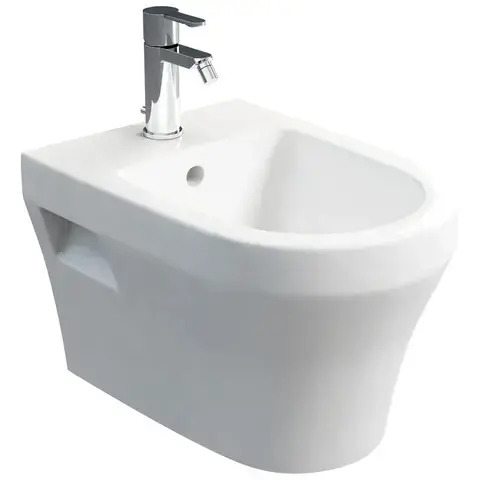
2. Back-to-Wall Bidet
A back-to-wall bidet sits flush to your bathroom wall. This bidet conceals all the plumbing lines and looks neat and tidy. Since this bidet is fixed to the wall, there’s no risk of damage to existing floor pipes during installation.
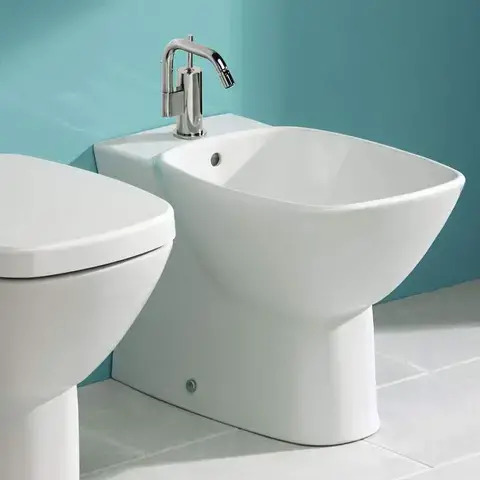
3. Floor-Standing Bidet
A floor-standing bidet is a completely self-contained, separate fixture that’s fixed to the floor of your bathroom. This bidet is easy to install and lasts longer than other bidets. They’re the most common type of bidet used in Japanese and Italian homes.
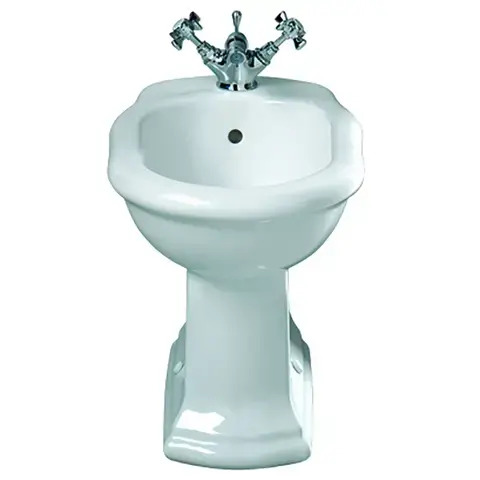
4. Bidet Toilet Seat
A bidet toilet seat is an all-in-one combo deal that delivers the benefits of both a toilet seat as well as a bidet. This bidet add-on option to your toilet has a more streamlined look.
While these bathroom fixtures have been around in the US for more than 50 years, they simply haven’t caught on in the UK as they should have. A bidet toilet seat is a great choice for a small bathroom that simply does not have the space for a bidet.
What Features Should I Look for When Choosing a Bidet?
All bidets spray a stream of water for cleaning. But if you are looking for a feature-rich bidet, you’ll need to consider the following features:
1. Water Temperature Control
When it comes to washing up after using the toilet, a stream of cold water can be unpleasant. And a spray of hot water on sensitive areas can feel even worse.
Therefore, water temperature control is vital, especially during winter when the temperature drops drastically.
Hot water bidets are mostly electric. That is, a built-in heater warms the water. A Zen Bidet Attachment can also deliver warm water.
2. Water Pressure Adjustment
Non-electric bidets typically provide more water pressure than anticipated. Since high water pressure can result in discomfort, you must always use the right pressure.
Water pressure adjustment is simple. Turning the pressure regulator knob clockwise increases the water pressure and turning it counter-clockwise reduces it.
3. Nozzle Positioning
Adjust the position of the nozzle towards the desired area for optimal hygiene. Aim the nozzle right on target, refining your aim until water flows to the right spot.
Nozzle maintenance is also important. Clean the nozzle regularly with a mild detergent and rinse it with water. Wipe the nozzle with a clean towel so that it is dry and free of germs.
4. Brand Reputation
Brand reputation is a major factor affecting a customer’s buying decision. It conveys reliability and trust. A strong brand reputation will also increase customer confidence.
Consider Burlington Bathrooms. They have been delivering cutting-edge luxury designs and bathroom solutions for over 20 years.
5. Warranty and Support
Often, consumers overlook the aftercare of the bathroom fixtures they buy. A recognised brand will, however, treat its clients well even years after they make a purchase.
Customer loyalty means everything to them because they aim to create and retain goodwill. They also offer an extended guarantee against manufacturing defects because they are confident in the quality of their products.
At Bathroom City, we pride ourselves on providing impeccable after-sales service.
What Are the Top Benefits of Using a Bidet Toilet?
Thanks to the COVID-19 pandemic, toilet paper has become a scarce – and precious – commodity. As a result, the demand for bidet toilets has skyrocketed. However, reducing the need for toilet paper isn’t the only benefit of using a bidet toilet.
Other benefits include:
- Bidets ensure that you and your hands remain cleaner.
- Bidets are more environment-friendly as you don’t need to flush tonnes of toilet paper down your plumbing lines, resulting in needless clogging issues.
- Since bidets spray plain water, they help address certain medical conditions – haemorrhoids and genital health concerns – better than wiping with toilet paper. Bidets can reduce the risk of developing haemorrhoids.
- Bidets are helpful for the elderly and people with mobility issues.
- Bidets are easy to install and relatively maintenance-free.
- Bidets deliver notable cost savings, although the initial investment might seem high. The long-term savings due to reduced reliance on toilet paper is significant.
- The water stream system used in bidets can help prevent skin irritation or discomfort from excessive wiping.
How Much Does a Bidet Cost?
The price of a basic bidet toilet is £185.00. The cost of premium models ranges from £235.00 to £245.00.
The cost of professional installation of this bathroom fixture ranges from £135.00 to £185.00. It is an additional cost factor you need to keep in mind. A bidet toilet, however, can be connected to your existing plumbing line but still needs fresh supply and waste lines.
Top Bidet Toilet Recommendations
Let’s take a quick look at some of the top bidet toilets.
i) Fitzroy Bidet
The Fitzroy Bidet brings the grandeur of Edwardian times into your bathroom. This carefully crafted stunning piece is made of the finest vitreous china ceramic. With a 5-year guarantee from Bayswater, this bidet is indeed a stress-free buy.
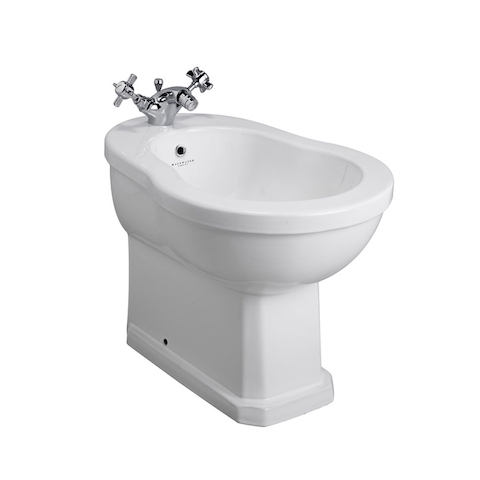
ii) Burlington Wall Hung Bidet
The Burlington Wall Hung Bidet captures the splendour of a bygone era. The curved wall-hung design is ideal for a small bathroom as it saves floor space. This bidet evokes a striking appeal with its fine blend of excellent craftsmanship and supreme function.
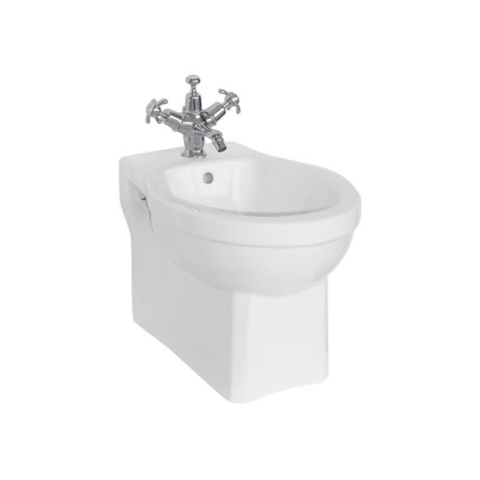
iii) Burlington Bidet
The unique and stylish Burlington Bidet with One Tap Hole and Overflow is the ultimate addition to a contemporary bathroom. This distinctively styled elegant fixture will ensure your bathroom looks fresh and special for years to come.
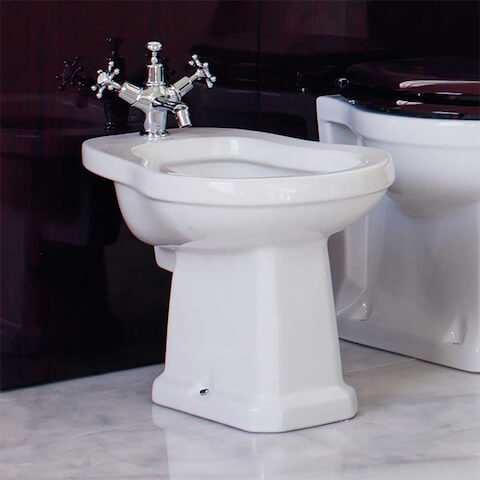
iv) Richmond Bidet
The eye-catching gloss white finish Richmond Bidet comes with a 5-year guarantee from Hudson Reed. This fixture will enhance your bathroom layout effortlessly. This skillfully crafted hard-wearing product is made from the finest ceramic material.
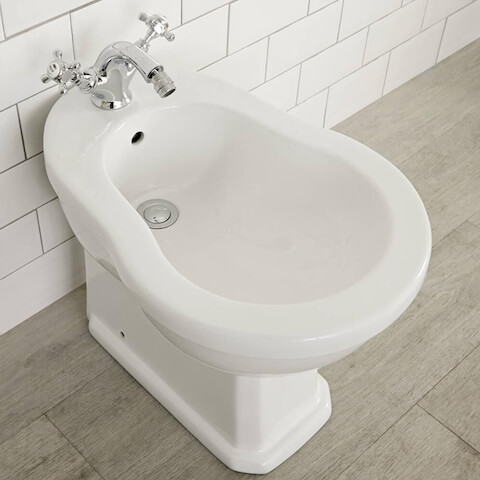
Shop Bidet Toilets
At Bathroom City, in addition to the bidets detailed above, you can shop for designer bidet units. You can pick the best bidet from our choice selection – from the traditional to the ultra-modern.
We assure you of the most competitive prices online for bidets. Browse through our exquisite selection and choose the perfect bidet for your existing or new bathroom.
Other related articles that you might also be interested in: